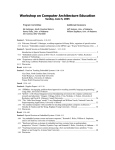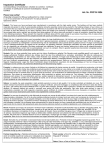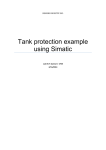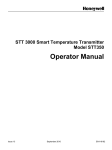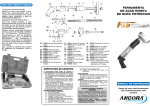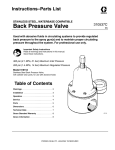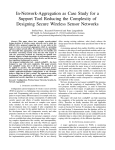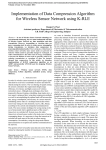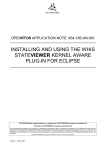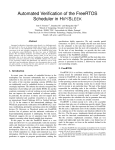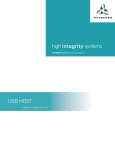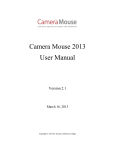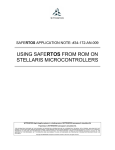Download Implementation of MPU for a Safe FreeRTOS Frame-work
Transcript
International Journal on Recent and Innovation Trends in Computing and Communication Volume: 3 Issue: 5 ISSN: 2321-8169 2558 - 2561 _______________________________________________________________________________________________ Implementation of MPU for a Safe FreeRTOS Frame-work Bhavesh Shah Babu Krishnamurthy Embedded System Design GTU PG School, Gujarat Technological University Ahmedabad, India. [email protected] Teaching faculty Embedded System Design CDAC - ACTS Pune, India [email protected] Abstract - In the embedded world, there are some types of applications which needed to perform with higher accuracy, with safety of data and application, robustness, with a very small footprint and very high performance. This all features are mostly preferred in most of Real Time Operating System (RTOS). But in RTOS itself, there are some problems like data corruption due to some bugs in some part of the code. Due to any illegal access to any part/peripherals/data could cause crash of the whole system. For such kind of applications like safety critical applications in which such things needed to be taken for not letting the system to crash there is a need of having OS, which will provide all the features which we have just discussed. Here in this paper, we propose a way of getting our desired performance from an open source OS FreeRTOS with its IO framework and running those in MPU mode. With the help of some Memory Protection Unit isolation for user space and system specs, different tasks from each other and system space can be achieved. It can achieve by providing MPU functionality in port layer and isolating different tasks data. And provide a protection to FreeRTOS. Keywords- FreeROTS, Safety critical application, Memory Protection Unit (MPU). __________________________________________________*****_________________________________________________ I. INTRODUCTION Certain embedded applications can be called as safety critical application like flight critical aircraft control, aerospace, nuclear, automotive, medical areas. These applications can be explained as that while in the process it is not allowed to have any kind of error, latency more than a particular limit. It is such a critical application that if any kind of problem comes in any stages of its running time it could cause a lot of damage to lives and money. Such kind of faults comes in cases like a very small fault can create some error or delay and then that leads to failure. Due to the failure of such a small part of the system can cause faults in another part of systems which depend on that part. It leads to the failure of that part of the system too, then could be whole system failure [1]. FreeRTOS [2] is an open source RTOS, but for applying this OS for such safety critical applications, it is not suitable because its functional model, subjected to a full HAZOP, it has weakness within the functional modal and API, and not having safety requirements. [3]. Now, as we see earlier that system failure starts from the failure of a small part of a system can cause avalanches of faults and failure in the system. To avoid that we can provide some permission to access amount of memory for certain part of the code. Which can be provided using Memory Protection Unit (MPU). The MPU is a part of the processor, which defines which part of memory to access and which part to not. If MPU is used in such application running on FreeRTOS. It would provide safety from those cascaded fault-error-failure as parts of systems would be isolated with each other. Yamada et al. [8] say that Memory Protection using Memory Management Unit (MMU) can have more latency due to more number of page tables and the low level bit protection. And for the Real time application they suggest MPU should be used. SafeRTOS is the safety critical OS, which is licensed and not open source. Which also provide software of different Safety Integrity Levels to co-exist a Single Build of code without unwanted mutual interface with the use of MPU [4]. Stecklina et al. [9] say that with the use of MPU it enforces a secure isolation of individual activates. And also MPU support is suitable number of activities and memory segments and can handle an access control without a performance loss in most of the cases. Khan et al. [10] talk about MPU in the automotive industries in electronic control unit (ECU). As in the ECU there plenty numbers of electronically controlled unit which are produced sparely and brought together to create a complete system. And at the time of adding some extra add-on software with the main ECU application. It can be easily added if MPU is properly implemented in those applications. Greiner et al. [11] propose that multiple native software stacks are thus bound to share the resources without protection between them. NoC-MPU is a Memory Protection Unit allowing supporting the secure and flexible co-hosting of multiple native software stacks running in multiple protection domains, on any shared memory MP-SoC using a NoC. In such cases and implementation done till now we can make a conclusion that for the safety of the application isolation of different parts of the system. And that can be providing memory protection to those parts. So making, creating a safe FreeRTOS framework we need to create it in Memory Protection Unit mode. II. FREERTOS+IO FRAMW WORK FreeRTOS+IO framework is used for accessing peripheral. Figure 1 shows the layered architecture of the FreeRTOS+IO framework. When an application asks for any access to any peripheral while using FreeRTOS APIs then the first it goes the FreeRTOS+IO layer where they identify the which peripheral is being asked by the application layer to be accessed. Then it goes to peripheral driver library which would have specific access functions like open, read, write and ioctl with the help of FreeRTOS kernel. In those functions, it uses the CMSIS Driver’s functionality for accessing particular functionality of 2558 IJRITCC | May 2015, Available @ http://www.ijritcc.org _______________________________________________________________________________________ International Journal on Recent and Innovation Trends in Computing and Communication Volume: 3 Issue: 5 ISSN: 2321-8169 2558 - 2561 _______________________________________________________________________________________________ that peripheral. [6] Which directly goes to Devices available on the microcontroller and access those devices. On other side FreeRTOS kernel interfaces the Processor Peripheral with the help of a FreeRTOS HAL+BSP layer with CMSIS Library with its core peripheral functionality. the ready queue to run the TCB would be loaded in pxCurrentTCB and at the time of context switch the 4 regions from xMPUSettings including 1 stack region and 3 memories accessed regions for that task would be loaded in those 4 configurable regions of MPU registers. When another task is scheduled than same process take in place and that task’s 4 regions would take place in those last 4 MPU configurable regions. After enabling the MPU rest of the memory space which is not being included in any memory region is known as background memory regions. MPU provides two access permission over here that all the background region could be privileged access only that could be no access allowed [5]. Figure 2 and Figure 3 shows the memory regions created at starting of the scheduler, and when different tasks are being scheduled. Background region is important in that way the task which is scheduled at a time will be bound to those 8 regions only. In the case of privileged background the task is in unprivileged mode, so it would not allow to access memory region except then those 8 regions. While talking about no background access the background region would not be allowed to access anything except 8 regions. Figure 3 has been discussed further. Figure 1: FreeRTOS+IO Framework With the help of an IO layer FreeRTOS kernel creates a handler which is the object of structure Peripheral_Control_t which would have pointers to functions of reading, writing, ioctl and other peripheral related members. This object is being created dynamically and stored in the heap memory area. FreeRTOS+IO APIs with the help of such handler of the peripherals they can communicate with peripheral devices. Here we use LPC 1769 Embedded Artist Baseboard for implementations of safe FreeRTOS implementation. III. MEMORY PROTECTION UNIT (MPU) Processor who has MPU here in our case Cortex M3 works normally if the MPU is not being activated. But if MPU is activated, then the processor can access only those memory regions which are mentioned in MPU registers as per its access permissions. If the memory access violates any access permission, then the Memory Management faults will be called. Here in Cortex M3 only 8 regions are allowed to create. Regions are allowed to modify at run time. And if a part of memory is there in two different regions, then the memory access permission would be as per the latest memory region’s access permissions [5]. IV. FREERTOS IN MPU MODE FreeRTOS distribute its workload in different tasks. FreeRTOS in MPU mode at the time of starting the scheduler the basic MPU regions are being set up. 4 regions out of 8 will be set up at the time of starting of the scheduler. And those are privileged function region, the code reads only region, privileged data region, and full accessed peripheral region. Those regions will be the permanent region after this point of time, because it would be same for all the tasks. Then remaining 4 regions would be like the configurable MPU regions for tasks. When a particular task is being taken from Figure 2: Memory map for background privileged access only Here MPURNR indicate the number of the memory region stored in MPU registers. V. FREERTOS+IO IN MPU MODE We will talk for the both background cases separately. First, we will talk about background privileged access only then we will talk about background access not allowed. In the FreeRTOS+IO framework most of the hardware setup is being done in the main( ) area only. Now at this time MPU is not being enabled. Over here handler for particular peripheral is being created with the use of FreeRTOS+IO APIs. Then after creating a number of tasks in restricted mode using xTaskCreateRestricted( ). With appropriate priority and required handlers of the peripherals as task’s parameters and memory regions to be allowed to be accessed by that task. These all tasks are created to run in unprivileged mode only or sometime after getting 2559 IJRITCC | May 2015, Available @ http://www.ijritcc.org _______________________________________________________________________________________ International Journal on Recent and Innovation Trends in Computing and Communication Volume: 3 Issue: 5 ISSN: 2321-8169 2558 - 2561 _______________________________________________________________________________________________ some global data needed for the task the switch to unprivileged mode. Figure 3: Memory map for background access not allowed At the point when the task is brought to the unprivileged mode its start, its real work they start communicating with the peripherals. This is the time when tasks are running after start of the scheduler and after setting up those default four memory region and enabling MPU with a background region in privileged access only permits. Here the handler memory regions which are taken from heap pool. That part of memory is now in privileged access mode if there is not included in any region. In our case it is not. In this case, that task would not allowed to access that handler of peripheral. This is happening because FreeRTOS+IO APIs are not jumping into the system space to do its functionality. To solve this we include FreeRTOS+IO’s APIs in mpu_wrappers.h and make sure that those APIs functionalities execute in privileged mode only. By doing this we are adding FreeRTOS+IO’s APIs as a part of FreeRTOS kernel. This can be explained nicely as shown in the Figure 4. So here we would able to douse FreeRTOS+IO framework in MPU mode with a background region in privileged access only case. Figure 4: FreeRTOS_write in MPU mode Now in the case of background region access not allowed everything in main( ) is same as in above case. But at the time of starting scheduler when the MPU is being set up and enabled over there background regions is given permissions as access not allowed. Now, after this point region excluded from those four basic regions would not be allowed to access. Only those regions which are being modified after this would have the access as per their permissions. At this point the problem comes that Main Stack Pointer (MSP) is now in no access permission and with that all the data and the handlers for devices distributed on whole SRAM would be now in no access area. So neither privileged nor unprivileged code area can access that part. And the data would be in very large amount so it is not possible to create a separate memory region for those data. So for the solution of this problem here we create whole SRAM in privileged access permission in stand of a region of privileged data’s region. As whole SRAM would become memory space with privileged access only normal task in our case which all are in unprivileged mode would not be allowed to access those memory regions unless that particular data’s regions as one of the memory region of the 3 memory region allowed to be accessed by that task. Till now we are able to create system space which would include the processor peripheral, and data stored in SRAM. This all part would be accessed by the function or code which would be in privileged mode. And another part is in user space which is doing communication work and our required functionality which is distributed in the form of different tasks. These all tasks have their own memory regions to access. And they cannot access anything else than that. As shown in figure 2 and 3 we can have an idea, how would be those memory regions for tasks. There is no fixed that there would be 8 regions of memory every time for every task. It can be less than that as per the requirements of the task. First four regions would be there every time, but last 4 regions would be changing as per the requirement of current task or any handler is running at that time. And talking about the peripheral usage, all the peripheral handlers would be in the area of privileged access only. So any task just can’t access those handlers as they all are in unprivileged mode, unless if we don’t give the handler to be accessed by that particular task. If a task is designed to do certain functionality so with the help of the handler object created at the time of opening that peripheral is passed to that task. That handler is itself is the address of the object created for that peripheral. Now if a task is not passed to that particular handler which that task want to access during its execution. If a task is allowed to access a handler of a particular peripheral so it mean it is allowed to access that particular drivers of that peripheral. If a developer tries to access peripheral in a task which is not allowed at the time of development. It would not be possible. Thus, this system would become more robust. The isolation for a particular task from another task and with peripheral drivers it can be explained from the Figure 5. Here a task 1 is allowed to access a particular peripheral so it can access it with the mode switching mechanism as explained earlier. So after such implementation if any part of system fails due to error in any of faults. They will not make any kind of effect on other part of systems as all the part of systems would be isolated from each other. It also provide the safety at the development level of the system. As by the mistake of the coder some data is been tried to be used by some part of the system which that part is not allowed to access then the system would create Memory Management fault at the debugging time. So it also provides robustness to the system. Here we provide the rules to different parts of the system by giving them access permission and provide them isolation from each other and create an environment where different safety integrity levels to co-exist on a single build of code without 2560 IJRITCC | May 2015, Available @ http://www.ijritcc.org _______________________________________________________________________________________ International Journal on Recent and Innovation Trends in Computing and Communication Volume: 3 Issue: 5 ISSN: 2321-8169 2558 - 2561 _______________________________________________________________________________________________ unwanted mutual interface the use of MPU as we talked in introduction part. Figure 5: task 1's Isolation for IO VI. CONCLUSION This latter describe Memory Protection Unit alone itself, it gives protection from using unwanted memory access. But now after using MPU in FreeRTOS+IO framework with MPU mode, we can say that we can have protection for not just unwonted memory access but also we can have protection in using peripherals also. Devices connected to the microcontroller can also be protected from unwanted access. FreeRTOS is freely available, easy to use RTOS. For using this OS for some safety critical application the approach mention in this latter can be helpful. For more safety this OS can also be scaled down as per the requirement of the application and can be made safer as per the application. 8th IEEE International Symposium. 19-21 June 2013.Pages : 225-231 [9] Akram Khan,AchimSchäfer, and MarkusZetlmeisl “Efficient Memory-Protected Integration of Add-On Software Subsystems in Small Embedded Automotive Applications”. Industrial Informatics, IEEE Transactions on (Volume: 3, Issue: 1), 12 February 2007, Pages: 45-50. [10] JoelPorquet, Alain Greiner, and ChristianSchwarz “NoC-MPU: a secure architecture for flexible co-hosting on shared memory MPSoCs”. Design, Automation and Test in Europe Conference and Exhibition ,2011, 14-18 March 2011, Pages: 1-4. VII. REFERENCES [1] [2] [3] [4] [5] [6] [7] [8] “Architecture of safety-critical systems”, http://www.embedded.com/design/prototyping-anddevelopment/4006464/Architecture-of-safety-critical-systems "FreeRTOS official site", http://www.freertos.org “SafeRTOS officail site”, http://www.highintegritysystems.com/safertos/upgrade-fromfreertos-to-safertos/ SafeRTOS_Datasheet, Upgrading_from_FreeRTOS_to0_SafeRTOS_v3 CortexM3Technical Reference Manual. LPC176x/5x User manual “ CMSIS introduction by ARM ”, http://www.arm.com/products/processors/cortex-m/cortexmicrocontroller-software-interface-standard.php Shimpei Yamada, YukikazuNakamoto, “Protection Mechanism in Privileged Memory Space for Embedded Systems, Real-Time OS” Distributed Computing Systems Workshops (ICDCSW), 2014 IEEE 34th International Conference onJune 30 2014-July 3 2014. Pages: 161 – 166. Oliver Stecklina, Peter Langendoerfer, Hannes Menzel, “Design of a tailor-made Memory Protection Unit for Low Power Microcontrollers”.Industrial Embedded Systems (SIES), 2013 2561 IJRITCC | May 2015, Available @ http://www.ijritcc.org _______________________________________________________________________________________






